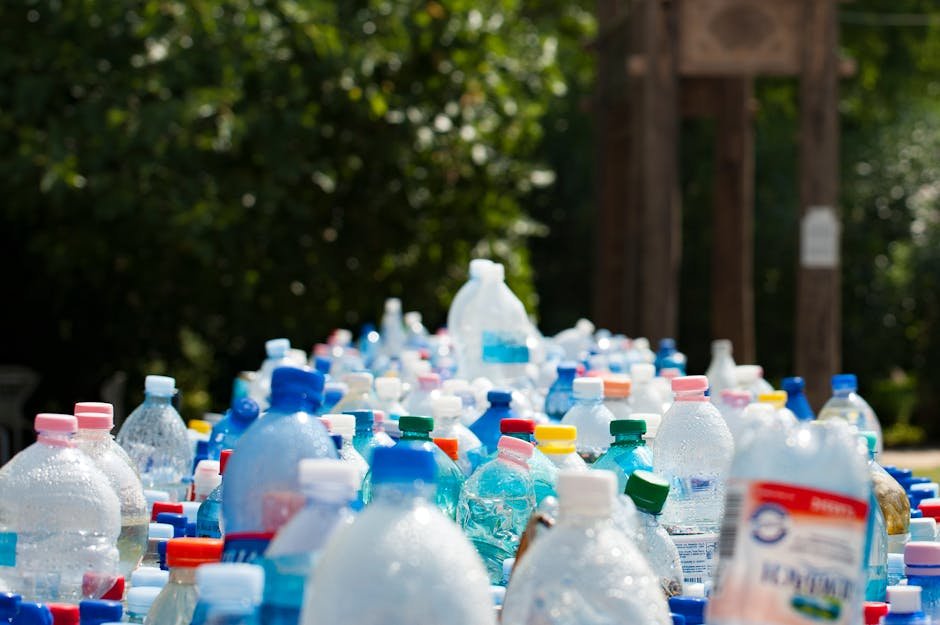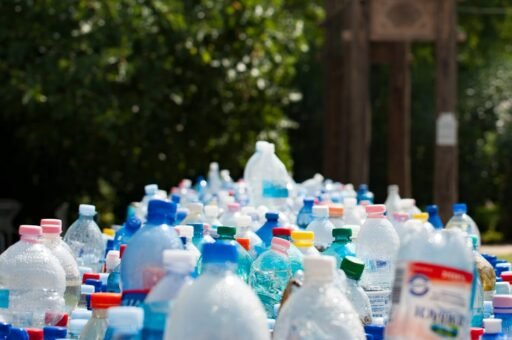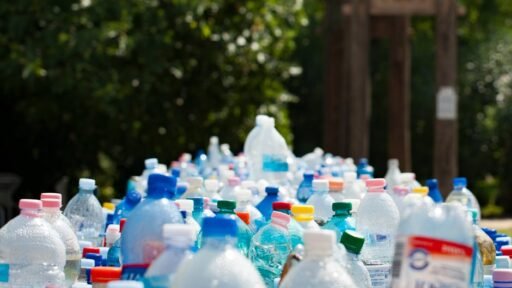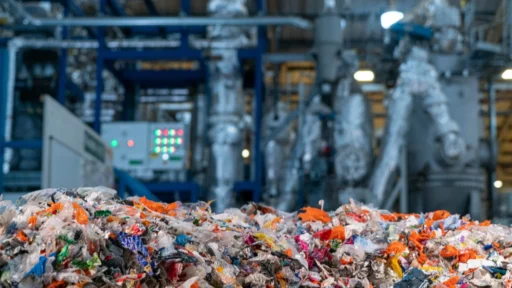-
Table of Contents
- Introduction
- Closed-Loop Systems: Achieving A Circular Economy Through Plastic Recycling
- The Role Of Artificial Intelligence In Revolutionizing Plastic Recycling
- Biodegradable Plastics: A Sustainable Solution For The Future
- Advanced Sorting Technologies: Enhancing Efficiency In Plastic Waste Management
- Innovations In Chemical Recycling: Breaking Down Plastics At The Molecular Level
- Q&A
- Conclusion
Introduction
The Latest Advances in Plastic Recycling Technology
Plastic recycling has become a critical focus in the global effort to combat environmental pollution and promote sustainable practices. Recent advancements in plastic recycling technology have significantly improved the efficiency, cost-effectiveness, and environmental impact of recycling processes. Innovations such as chemical recycling, advanced sorting technologies, and biodegradable plastics are transforming the industry. Chemical recycling, for instance, breaks down plastics into their original monomers, allowing for the creation of new, high-quality plastics. Advanced sorting technologies, including AI and machine learning, enhance the accuracy of separating different types of plastics, reducing contamination and increasing the purity of recycled materials. Additionally, the development of biodegradable and compostable plastics offers promising alternatives to traditional plastics, further reducing the environmental footprint. These cutting-edge technologies are paving the way for a more sustainable future by addressing the challenges associated with plastic waste and promoting a circular economy.
Closed-Loop Systems: Achieving A Circular Economy Through Plastic Recycling
Closed-loop systems represent a significant leap forward in the quest to achieve a circular economy through plastic recycling. These systems are designed to ensure that plastic materials are continuously reused, thereby minimizing waste and reducing the need for virgin plastic production. The latest advances in plastic recycling technology are pivotal in making closed-loop systems more efficient and effective.
One of the most notable advancements is the development of advanced sorting technologies. Traditional recycling methods often struggle with the accurate separation of different types of plastics, which can lead to contamination and reduced quality of the recycled material. However, new sorting technologies, such as near-infrared (NIR) spectroscopy and artificial intelligence (AI)-driven systems, have significantly improved the precision of plastic identification and separation. These technologies enable recyclers to sort plastics with greater accuracy, ensuring that the recycled material is of higher quality and more suitable for reuse in manufacturing processes.
In addition to improved sorting, chemical recycling has emerged as a groundbreaking technology in the realm of plastic recycling. Unlike mechanical recycling, which involves physically breaking down plastics into smaller pieces, chemical recycling breaks down plastics at the molecular level. This process allows for the recovery of monomers, which can then be re-polymerized to create new plastics with properties identical to those of virgin materials. Chemical recycling not only expands the range of plastics that can be recycled but also enhances the quality and durability of the recycled products, making them more competitive with virgin plastics.
Moreover, the integration of blockchain technology into plastic recycling systems has introduced a new level of transparency and traceability. Blockchain can be used to create a digital ledger that records every step of the recycling process, from collection to final product manufacturing. This transparency ensures that recycled materials are properly tracked and verified, reducing the risk of contamination and fraud. Additionally, it provides consumers and manufacturers with confidence in the sustainability and authenticity of recycled products, thereby encouraging greater participation in closed-loop systems.
Another critical advancement is the development of biodegradable and compostable plastics. While these materials are not a direct solution to plastic recycling, they play a complementary role in closed-loop systems by addressing the issue of plastic waste that cannot be easily recycled. Biodegradable plastics are designed to break down more quickly and safely in natural environments, reducing the long-term environmental impact of plastic waste. When used in conjunction with traditional recycling methods, these materials can help to create a more holistic approach to managing plastic waste.
Furthermore, the implementation of extended producer responsibility (EPR) programs has been instrumental in promoting closed-loop systems. EPR programs require manufacturers to take responsibility for the entire lifecycle of their products, including end-of-life disposal and recycling. By incentivizing manufacturers to design products with recyclability in mind and to invest in recycling infrastructure, EPR programs help to create a more sustainable and efficient recycling ecosystem.
In conclusion, the latest advances in plastic recycling technology are driving the development of closed-loop systems that are essential for achieving a circular economy. Improved sorting technologies, chemical recycling, blockchain integration, biodegradable plastics, and extended producer responsibility programs are all contributing to a more efficient and sustainable approach to plastic waste management. As these technologies continue to evolve and mature, they hold the promise of significantly reducing the environmental impact of plastic waste and paving the way for a more sustainable future.
The Role Of Artificial Intelligence In Revolutionizing Plastic Recycling

Artificial intelligence (AI) is increasingly becoming a cornerstone in the quest to revolutionize plastic recycling, offering unprecedented advancements in efficiency, accuracy, and scalability. As the global community grapples with the mounting plastic waste crisis, the integration of AI into recycling processes presents a promising solution to enhance the effectiveness of plastic waste management. This technological synergy is not only optimizing the sorting and processing of plastics but also paving the way for more sustainable and economically viable recycling practices.
One of the most significant contributions of AI in plastic recycling is its ability to improve the sorting process. Traditional methods of sorting plastics often rely on manual labor or rudimentary mechanical systems, which are prone to errors and inefficiencies. AI-powered systems, however, utilize machine learning algorithms and computer vision to identify and categorize different types of plastics with remarkable precision. These systems are trained on vast datasets of plastic images, enabling them to recognize subtle differences in color, texture, and shape that human eyes might miss. Consequently, AI-driven sorting machines can achieve higher accuracy rates, reducing contamination and ensuring that plastics are correctly separated for recycling.
Moreover, AI is instrumental in enhancing the operational efficiency of recycling facilities. By integrating AI with Internet of Things (IoT) devices, recycling plants can monitor and analyze real-time data on machine performance, energy consumption, and material flow. This data-driven approach allows for predictive maintenance, minimizing downtime and optimizing the overall efficiency of the recycling process. For instance, AI algorithms can predict when a machine is likely to fail and schedule maintenance before a breakdown occurs, thereby reducing operational disruptions and associated costs.
In addition to improving sorting and operational efficiency, AI is also playing a crucial role in developing new recycling techniques. Advanced machine learning models are being used to design innovative chemical recycling processes that can break down complex plastic polymers into their constituent monomers. These monomers can then be repurposed to create new plastics, effectively closing the loop in the plastic lifecycle. This approach not only addresses the limitations of mechanical recycling, which often degrades the quality of plastics, but also offers a more sustainable solution by enabling the continuous reuse of plastic materials.
Furthermore, AI is facilitating the development of smart recycling systems that can adapt to the ever-changing landscape of plastic waste. As new types of plastics and packaging materials are introduced, AI algorithms can be continuously updated to recognize and process these materials. This adaptability ensures that recycling systems remain effective and relevant, even as the composition of plastic waste evolves. Additionally, AI-driven analytics can provide valuable insights into consumer behavior and waste generation patterns, informing policy decisions and promoting more sustainable consumption practices.
The integration of AI in plastic recycling is not without its challenges. The initial investment in AI technology and infrastructure can be substantial, and there is a need for skilled personnel to develop and maintain these systems. However, the long-term benefits of AI-driven recycling, including increased efficiency, reduced environmental impact, and economic viability, far outweigh these initial hurdles. As AI technology continues to advance, its role in plastic recycling is expected to expand, offering new opportunities to tackle the plastic waste crisis more effectively.
In conclusion, artificial intelligence is revolutionizing plastic recycling by enhancing sorting accuracy, operational efficiency, and the development of innovative recycling techniques. Through the integration of AI, recycling facilities can achieve higher precision, reduce contamination, and optimize their processes, ultimately contributing to a more sustainable and circular economy. As the technology continues to evolve, the potential for AI to transform plastic recycling and address the global plastic waste challenge is immense, heralding a new era of environmental stewardship and resource management.
Biodegradable Plastics: A Sustainable Solution For The Future
The Latest Advances in Plastic Recycling Technology
In recent years, the environmental impact of plastic waste has become a pressing global concern, prompting significant advancements in plastic recycling technology. Among these innovations, biodegradable plastics have emerged as a promising solution for mitigating the detrimental effects of traditional plastics. These materials, designed to decompose more rapidly under specific environmental conditions, offer a sustainable alternative that aligns with the principles of a circular economy. As we delve into the intricacies of biodegradable plastics, it is essential to understand their composition, degradation mechanisms, and the technological strides that have facilitated their development.
Biodegradable plastics are primarily derived from renewable biomass sources such as corn starch, sugarcane, and cellulose. Unlike conventional plastics, which are synthesized from petrochemicals, these biopolymers are engineered to break down through natural processes involving microbial activity. This biodegradation process results in the conversion of the plastic into water, carbon dioxide, and biomass, thereby reducing the accumulation of persistent waste in the environment. The development of biodegradable plastics has been driven by advancements in polymer science, which have enabled the creation of materials with tailored properties to meet specific application requirements.
One of the critical factors influencing the performance of biodegradable plastics is the rate and extent of degradation. This is determined by the chemical structure of the polymer, environmental conditions, and the presence of microorganisms capable of metabolizing the material. Recent research has focused on enhancing the biodegradability of these plastics through the incorporation of additives that promote microbial activity and the development of copolymers with optimized degradation profiles. For instance, polylactic acid (PLA) and polyhydroxyalkanoates (PHA) are two widely studied biodegradable polymers that have shown significant promise due to their favorable mechanical properties and biodegradation rates.
The integration of biodegradable plastics into existing waste management systems presents both opportunities and challenges. On one hand, these materials can be processed through industrial composting facilities, where controlled conditions facilitate rapid degradation. On the other hand, the presence of biodegradable plastics in conventional recycling streams can pose contamination risks, necessitating the development of advanced sorting technologies. Innovations such as near-infrared (NIR) spectroscopy and machine learning algorithms have been employed to improve the accuracy of plastic identification and separation, thereby enhancing the efficiency of recycling operations.
Moreover, the environmental benefits of biodegradable plastics extend beyond waste reduction. The production of these materials typically involves lower greenhouse gas emissions compared to traditional plastics, contributing to a reduction in the overall carbon footprint. Additionally, the use of renewable feedstocks helps to decrease reliance on fossil fuels, further promoting sustainability. However, it is crucial to consider the full life cycle of biodegradable plastics, including factors such as land use, water consumption, and potential impacts on food security, to ensure that their adoption does not inadvertently create new environmental challenges.
In conclusion, biodegradable plastics represent a significant advancement in the quest for sustainable plastic solutions. Through continued research and technological innovation, these materials have the potential to play a pivotal role in reducing plastic pollution and advancing the goals of a circular economy. As the field progresses, it will be essential to address the associated challenges and optimize the integration of biodegradable plastics into existing waste management systems. By doing so, we can pave the way for a more sustainable future, where the environmental impact of plastic waste is significantly diminished.
Advanced Sorting Technologies: Enhancing Efficiency In Plastic Waste Management
The latest advances in plastic recycling technology have significantly transformed the landscape of plastic waste management, particularly through the development of advanced sorting technologies. These innovations are crucial in enhancing the efficiency and effectiveness of recycling processes, addressing the growing environmental concerns associated with plastic waste. As the volume of plastic waste continues to escalate, the need for more sophisticated sorting mechanisms becomes increasingly imperative.
One of the most notable advancements in this domain is the implementation of near-infrared (NIR) spectroscopy. NIR technology has revolutionized the sorting process by enabling the rapid identification and separation of different types of plastics based on their unique spectral signatures. This method is highly efficient, allowing for the precise sorting of plastics such as polyethylene terephthalate (PET), high-density polyethylene (HDPE), and polypropylene (PP). The accuracy of NIR spectroscopy significantly reduces contamination levels in recycled plastic streams, thereby improving the quality of the recycled material and expanding its potential applications.
In addition to NIR spectroscopy, artificial intelligence (AI) and machine learning algorithms have been integrated into sorting systems to further enhance their capabilities. These technologies enable sorting machines to learn and adapt to various types of plastic waste, improving their accuracy and efficiency over time. By analyzing vast amounts of data, AI-driven systems can identify patterns and make real-time decisions, ensuring that plastics are sorted with unprecedented precision. This not only increases the throughput of recycling facilities but also minimizes the amount of plastic that ends up in landfills or incineration plants.
Moreover, the development of robotic sorting systems has introduced a new level of automation in plastic waste management. Equipped with advanced sensors and AI algorithms, these robots can identify and sort different types of plastics with remarkable speed and accuracy. Robotic arms, for instance, can pick and place plastic items from conveyor belts into designated bins, streamlining the sorting process and reducing the reliance on manual labor. This automation not only enhances operational efficiency but also addresses labor shortages and reduces the risk of human error.
Another significant advancement is the use of chemical markers and tracers in plastic products. These markers, which are invisible to the naked eye, can be detected by specialized sorting equipment, enabling the precise identification of plastic types and their respective properties. This technology is particularly useful for sorting complex plastic products and multi-layered packaging, which are often challenging to recycle using traditional methods. By incorporating chemical markers, recycling facilities can achieve higher purity levels in their output, making the recycled plastics more suitable for high-value applications.
Furthermore, the integration of blockchain technology in plastic waste management has emerged as a promising development. Blockchain provides a transparent and immutable record of the entire lifecycle of plastic products, from production to disposal. This traceability ensures that recycled plastics meet stringent quality standards and regulatory requirements. By leveraging blockchain, stakeholders can track the origin, composition, and processing history of plastic materials, fostering greater accountability and trust in the recycling process.
In conclusion, the latest advances in plastic recycling technology, particularly in advanced sorting technologies, have significantly enhanced the efficiency and effectiveness of plastic waste management. The implementation of NIR spectroscopy, AI and machine learning, robotic sorting systems, chemical markers, and blockchain technology has revolutionized the sorting process, ensuring higher purity levels and expanding the potential applications of recycled plastics. As these technologies continue to evolve, they hold the promise of addressing the global plastic waste crisis and contributing to a more sustainable future.
Innovations In Chemical Recycling: Breaking Down Plastics At The Molecular Level
The latest advances in plastic recycling technology have ushered in a new era of sustainability, with innovations in chemical recycling standing at the forefront. Unlike traditional mechanical recycling, which involves melting and reprocessing plastics, chemical recycling breaks down plastics at the molecular level, offering a more versatile and efficient solution. This method addresses the limitations of mechanical recycling, such as the degradation of material quality and the inability to process certain types of plastics.
One of the most promising techniques in chemical recycling is pyrolysis, a process that involves heating plastics in the absence of oxygen to break them down into smaller molecules. Pyrolysis can convert a wide range of plastic waste into valuable products such as synthetic crude oil, which can be further refined into fuels and chemicals. This not only diverts plastic waste from landfills but also reduces the reliance on fossil fuels, thereby contributing to a circular economy.
Another significant advancement is depolymerization, which targets specific types of plastics like polyethylene terephthalate (PET) and polystyrene. Depolymerization involves breaking down polymers into their monomers, which can then be purified and repolymerized into new plastics. This process maintains the quality of the material, allowing for the production of high-grade recycled plastics that can be used in a variety of applications, from packaging to automotive parts. The ability to recycle plastics without compromising their properties is a game-changer, as it opens up new possibilities for the reuse of materials that were previously considered non-recyclable.
Enzymatic recycling is another cutting-edge approach that leverages the power of biological catalysts to break down plastics. Researchers have identified and engineered enzymes capable of degrading PET into its constituent monomers. This method operates under mild conditions, making it more energy-efficient compared to traditional chemical processes. Moreover, enzymatic recycling offers the potential for selective degradation, which could simplify the sorting and processing of mixed plastic waste streams.
The integration of artificial intelligence (AI) and machine learning into chemical recycling processes is also making waves. AI can optimize reaction conditions, predict the behavior of different plastic types, and enhance the efficiency of recycling operations. By analyzing vast amounts of data, AI algorithms can identify patterns and correlations that human operators might overlook, leading to more effective and scalable recycling solutions.
Despite these advancements, challenges remain in the widespread adoption of chemical recycling technologies. Economic viability is a critical factor, as the costs associated with chemical recycling can be higher than those of mechanical recycling. However, ongoing research and development efforts are focused on improving process efficiencies and reducing costs. Additionally, regulatory frameworks and industry standards need to evolve to support the commercialization of these technologies.
Public awareness and consumer behavior also play a crucial role in the success of chemical recycling. Educating consumers about the benefits of chemical recycling and encouraging the proper disposal of plastic waste can drive demand for recycled products and support the growth of the recycling industry.
In conclusion, innovations in chemical recycling are revolutionizing the way we manage plastic waste, offering sustainable solutions that break down plastics at the molecular level. Techniques such as pyrolysis, depolymerization, and enzymatic recycling, combined with the power of AI, are paving the way for a more circular economy. While challenges remain, the continued advancement and adoption of these technologies hold the promise of a future where plastic waste is no longer a burden but a valuable resource.
Q&A
1. **What is chemical recycling in plastic waste management?**
Chemical recycling involves breaking down plastic waste into its basic chemical components, which can then be reused to produce new plastics, fuels, or other chemicals.
2. **How does enzymatic recycling work?**
Enzymatic recycling uses specialized enzymes to break down plastics, such as PET, into their monomers, which can then be re-polymerized into new plastic products.
3. **What is the role of pyrolysis in plastic recycling?**
Pyrolysis is a thermal decomposition process that converts plastic waste into synthetic crude oil, which can be refined into fuels or used to produce new plastics.
4. **What advancements have been made in mechanical recycling?**
Recent advancements in mechanical recycling include improved sorting technologies using AI and robotics, as well as enhanced washing and extrusion processes to produce higher-quality recycled plastics.
5. **What is the significance of solvent-based recycling?**
Solvent-based recycling dissolves plastics in specific solvents to separate and purify polymers, allowing for the recovery of high-quality materials that can be reused in manufacturing.
Conclusion
The latest advances in plastic recycling technology have significantly improved the efficiency and effectiveness of recycling processes. Innovations such as chemical recycling, which breaks down plastics into their original monomers for reuse, and advanced sorting technologies using AI and machine learning, have enhanced the purity and quality of recycled materials. Additionally, the development of biodegradable and compostable plastics offers sustainable alternatives to traditional plastics. These advancements collectively contribute to reducing plastic waste, conserving resources, and mitigating environmental impact, marking a substantial progress in the field of plastic recycling.





